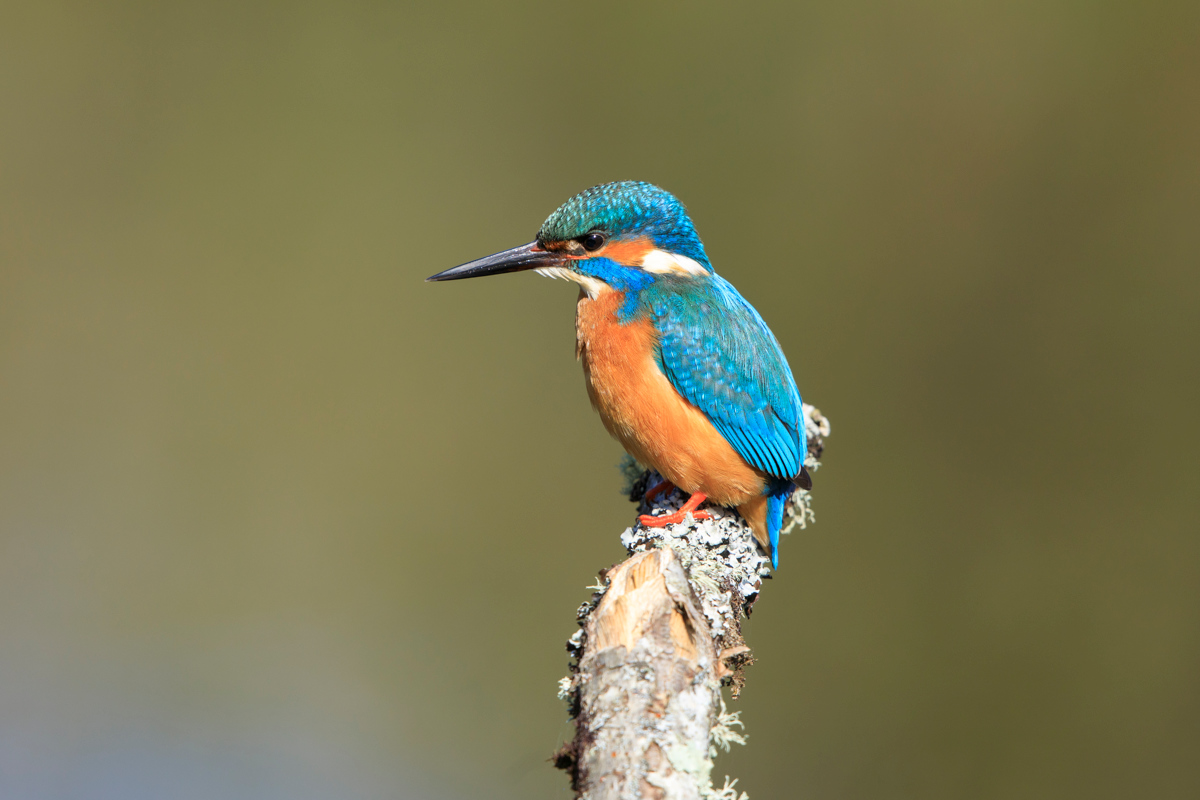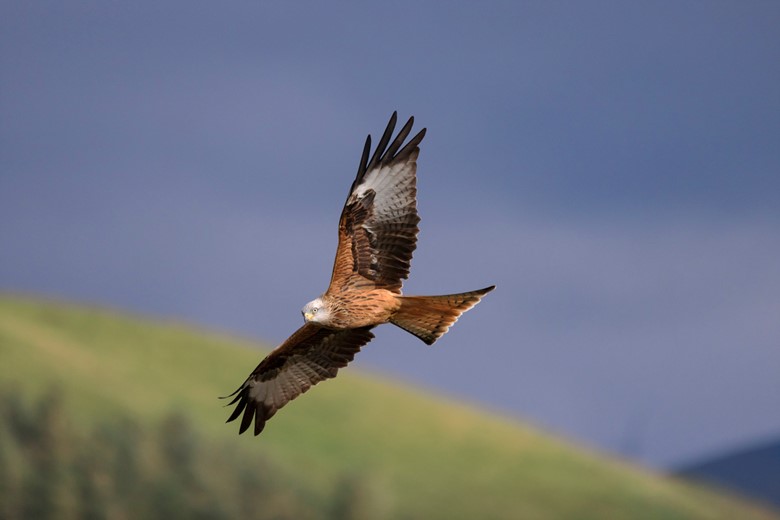
Barcutiaid Coch ym Mwlch Nant yr Arian
Mae'n hawdd adnabod y barcud coch, gyda'i gorff browngoch, ei adenydd llydan, ei gynffon fforchiog.
i weld yr adar gosgeiddig yma yn agos wrth iddynt gael eu bwydo, does unman gwell na Bwlch Nant yr Arian, lle mae tua 200 o adar yn ymgynull o belter cymaint a deg milltir i ffwrdd. Bae'r adar yn cael eu bwydo yn ddyddiol (2 o'r gloch y prynhawn yn y gaeaf, ac am dri o'r gloch yn yr haf) Weithiau mae barcud gwyn ei liw yn ymweld hefyd.
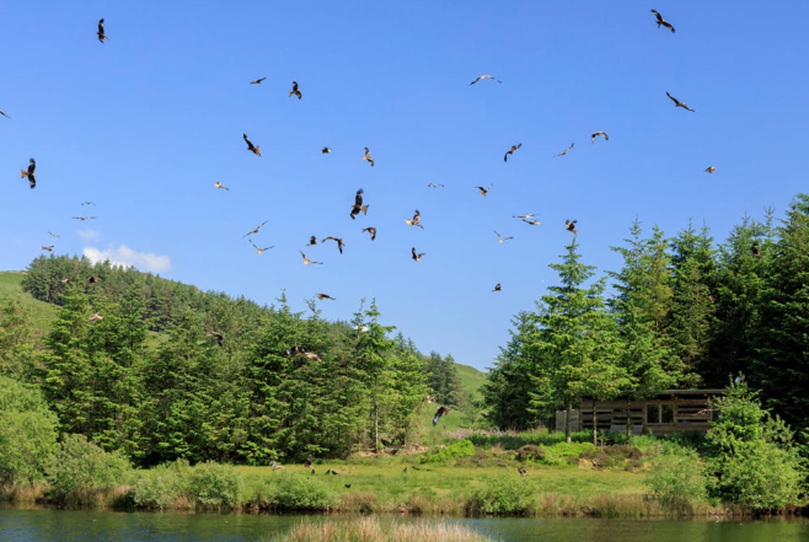
Er ei faint, ma'er barcud yn yn ysgafn ac ystwyth, gyda adenydd sydd tua 5 troedfedd o led, a chynffon fforchiog sydd yn ei alluogi i symud yn osgeiddig wrth hedfan. Daw'r adar i lawr ar wib tua'r ddaear i gipio'r bwyd a hefan bant eto yn gyflym i fwyta tra'n hedfan. Weithiau fe'u gwelwch yn rhannu bwyd gyda'u cymar neu'n ceisio cipio bwyd oddi ar eraill.
Gwarchodfa RSPB Ynyshir
Mae aber yr afon Dyfi yn lloches i nifer o adar hynod y glannau. Mae digon o fwydod a physgod cregyn ar gael yn y mwd a'r tywod i ddenu adar rhydio i'r gweunydd corsiog yn yr haf – fel y pibydd goesgoch neu'r gornchwiglen.
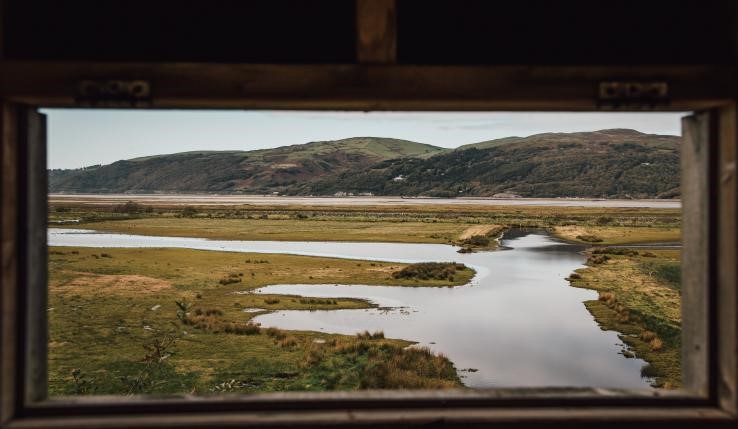
Little egrets were once a rare sight in Ceredigion but visitors to RSPB Ynys-hir can enjoy some close up encounters with these small herons on the live camera out at the Domenlas hide. Look out for their distinctive yellow feet.
Ducks and geese feed in large numbers on the saltmarshes in winter include barnacle geese and the only wintering population of Greenland white-fronted geese to regularly visit Wales. Wintering birds also include many ducks such as shelduck, wigeon and teal and waders such curlew and the distinctive red legged oystercatcher. 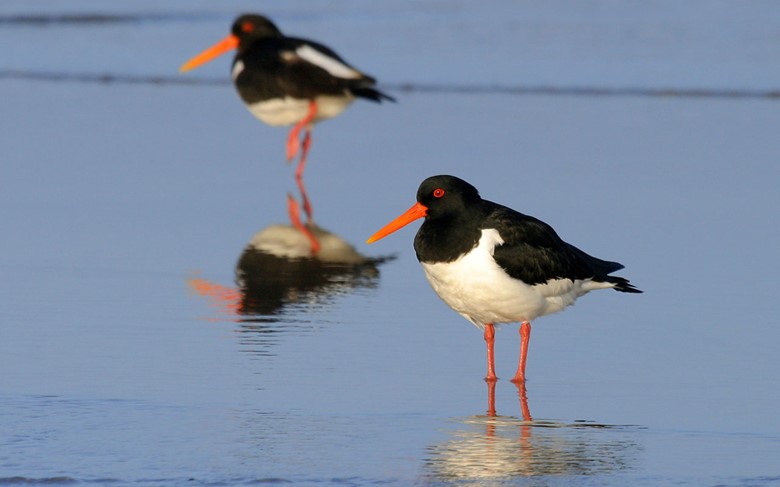
The curlew is the largest European wading bird. With its long, down-curved bill, brown upperparts, long legs and evocative, bubbling call, these wintering birds are unmistakeable out on the wet grassland and saltmarsh. Look for them from the Saltmarsh Trail.
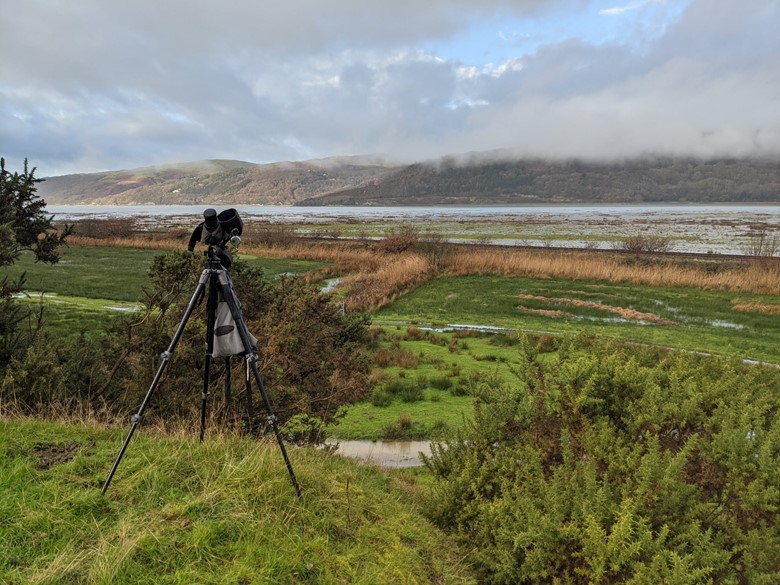
Summer migrant waders to look out for on the Dyfi marshes are green sandpipers and greenshanks. A good time to see many of these waders is at high tide when many of them congregate along the rising tide on the saltmarsh and sandflats.
Ynys-hir means "Long Island" in Welsh, perfectly describing the landscape of the reserve which extends along a wooded ridge overlooking the saltmarshes of the Dyfi estuary. It would once have been completely surrounded by marshland. The oak woodland supports pied flycatcher, redstart, wood warblers and lesser spotted woodpecker.
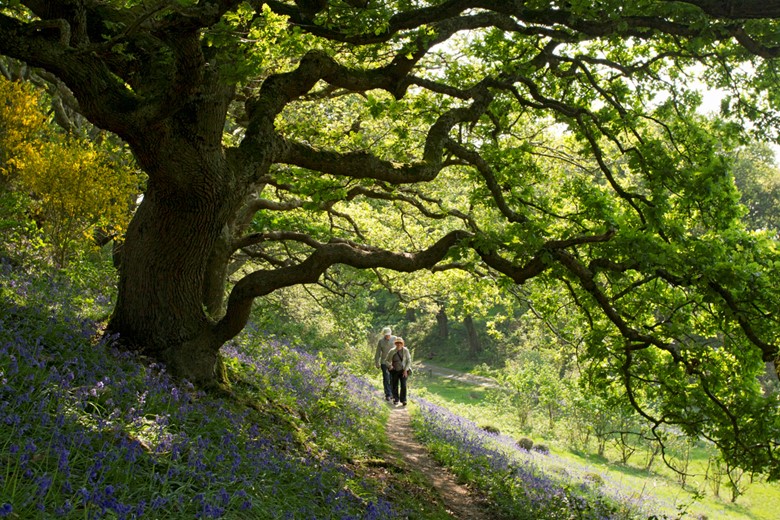
Today the reserve covers an area of 800 hectares with a wide mix of habitats including the saltmarsh of the Dyfi estuary, bog, reedbeds and freshwater pools to temperate or ‘Celtic rainforest’ woodland and heather clad mountain habitats. There are nature trails that loop around the reserve from the visitor centre and several hides and lookout points are dotted around the reserve.
Is it any surprise that BBC’s Springwatch was based at Ynys-Hir for the live broadcast during on three consecutive years: 2011, 2012 and 2014.
Ynyslas a Gwarchodfa Cors Dyfi
This extensive nature reserve covers 2,290 hectares and includes part of the Dyfi Estuary, Ynyslas dunes and Cors Fochno (Borth bog) – one of the largest and finest examples of a raised peat bog in Britain.
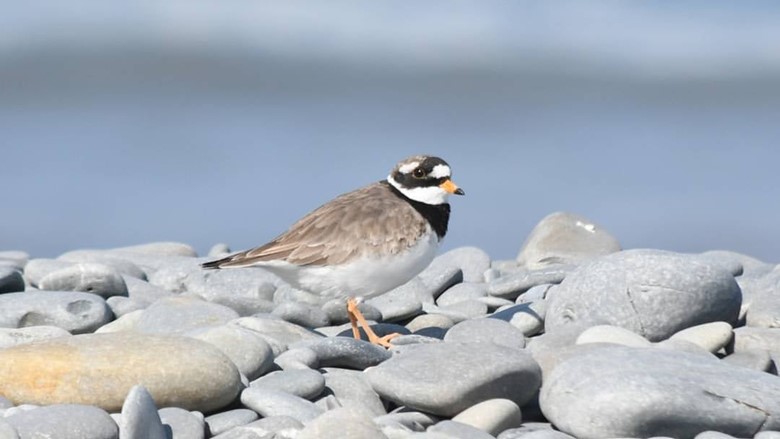
The dunes are a haven for all kinds of birds, including linnets, larks and stonechats. Nearby the pebbles on the beach provide a useful disguise for the eggs of the ringed plover. Almost impossible to spot, the only clue to the location of nests during the breeding season are the protective fencing around them!
Manx shearwaters are normally associated with some of the islands off the coast of Wales, but in late summer several thousand can appear in the shallow waters around Ynyslas and the Dyfi estuary.
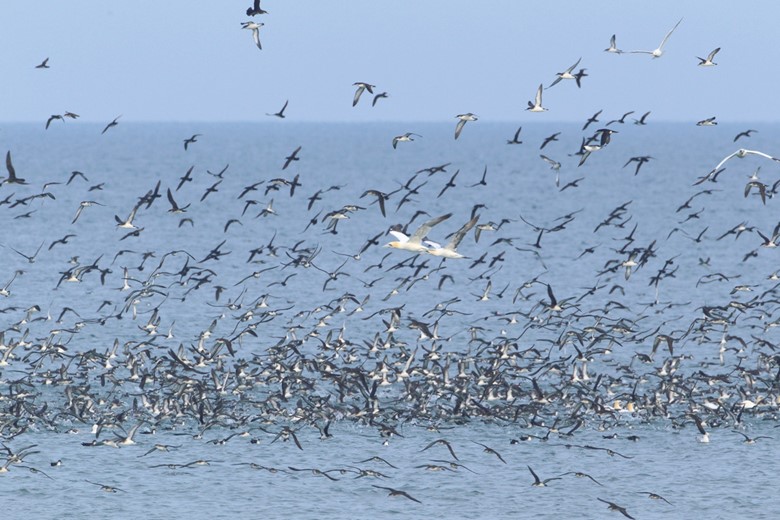
Breeding birds of the bog habitats include snipe, water rail, common snipe, stonechat, grasshopper warbler, sedge warbler, reed warbler and reed bunting.
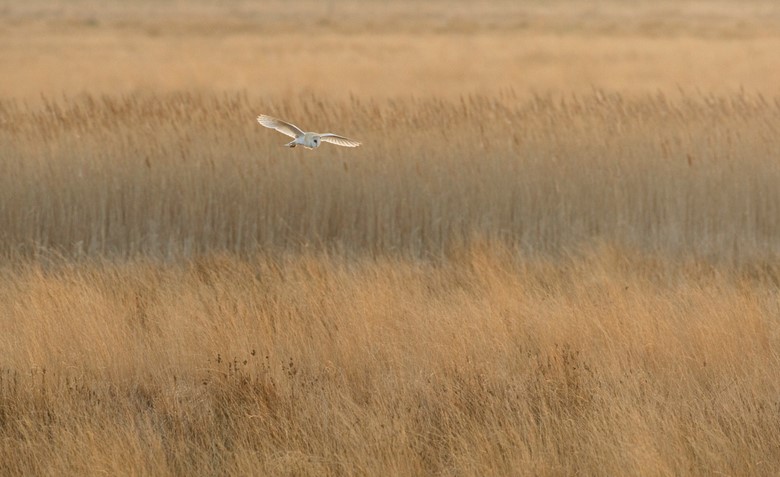
There is a public hide overlooking the River Leri and Cors Fochno, where you can spot a range of birds including curlew, snipe, redshank, black-tailed godwit and whimbrel. In winter, hen harrier, peregrine falcon and merlin can be seen hunting over the open bog.
Gweilch y Dyfi
The river Dyfi is an important hunting ground for Ospreys returning from overwintering in Africa. The ospreys of the Dyfi are keenly awaited from their long journey from Africa to nest on the Wildlife Trust reserve.They arrive in the spring and human visitors are able to observe the nest on CCTV trained on the birds' nest from the nearby Dyfi Wildlife Centre.
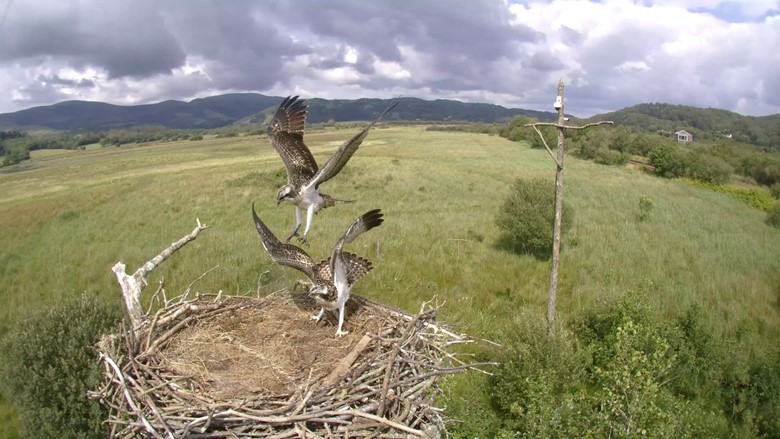
There is also an observatory you can reach along boardwalks across the Cors Dyfi bog reserve.
Gweld adar ar hyd Llwybr Arfordir Ceredigion
Aptly named Bird's Rock, about a mile south of New Quay along the Ceredigion coast path, is one of the best places to see Ceredigion's marine wildlife. A redundant coastguard's lookout repurposed to provide shelter for wildlife spotters is a great place to quietly observe the coming and goings of thousands of seabirds.
Can y tell the difference between a razorbill and a guillemot?
They usually stay well offshore once they have bred, and like many seabirds raise only a single chick. Both nest, often together in noisy colonies, on the coastal cliff ledges. The guillemots prefer to pack together, standing shoulder to shoulder on narrow ledges, while razorbills prefer clefts in the rock, or flatter wider outcrops.The razorbill has a short, thick bill that has distinguishing white lines across the end and around the eyes. The similar-looking guillemot is chocolate-brown in colour, and has a longer and thinner bill. Guillemots have short tails, razorbill have longer pointed ones.
Razorbills can dive very deep to catch fish. Only coming to shore to breed, on land it stands upright just like other auks.
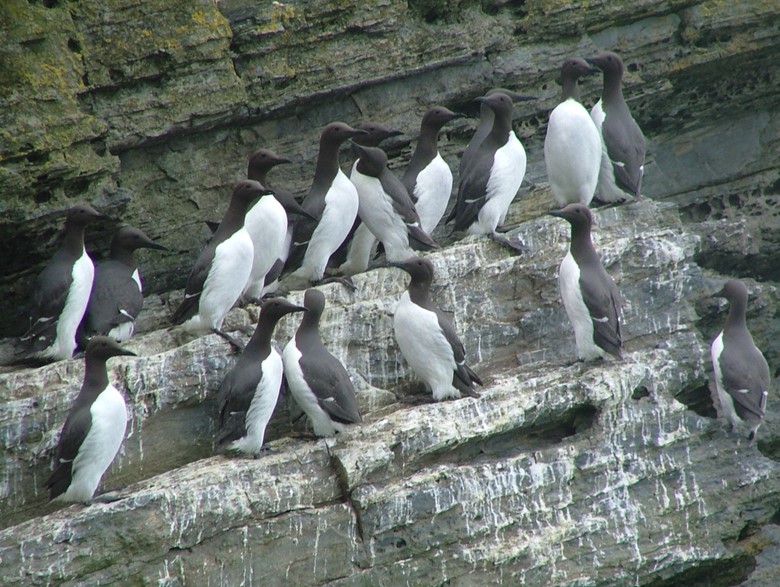
Gannets are the UK’s largest seabirds; with a six foot wing span, they make a spectacular sight as they dive for fish.
Fulmars are related to the albatross. They fly low over the sea, gliding and banking on stiff wings. At its breeding sites it will fly high up the cliff face, riding the updraughts. They defend their nests from intruders by spitting out a foul-smelling oil!
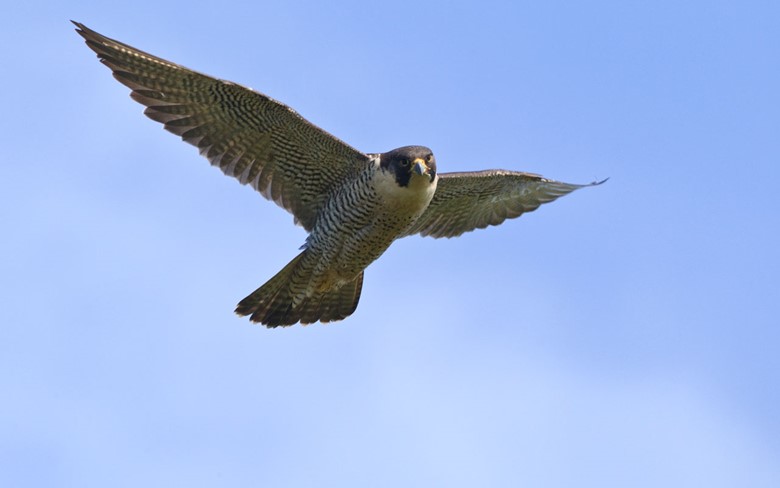
Kestrels are often seen hovering close to cliffs. The sea cliffs are also the haunt of Britain's fastest bird; peregrine falcons can reach speeds of 200mph.
Mwnt, Cwmtydu, and Cwm Soden, all National Trust protected coves with sea caves and contorted rock formations are perfect roosts for chough. The Welsh name ‘brân goes goch’ means red-legged crow and this special member of the crow family is instantly recognisable by its red legs, red bill and glossy black plumage.
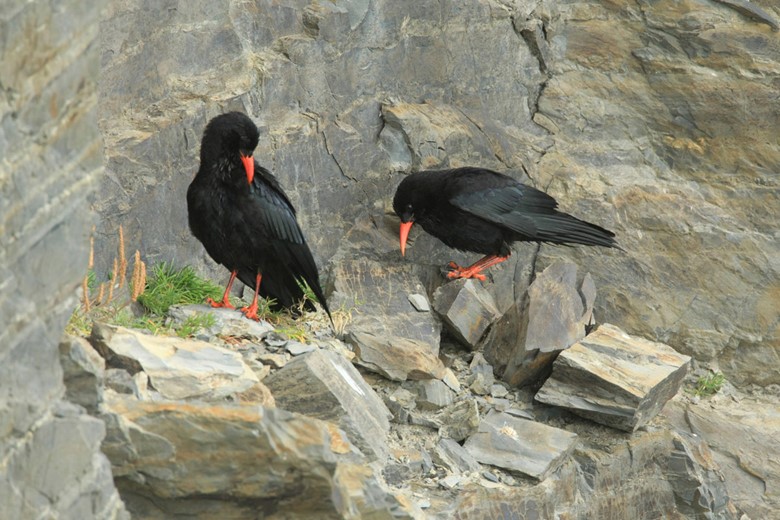
Chough roost communally on rock faces, building their nests in crevices and recesses in the rock using twigs, roots and moss and lining them with sheep wool and thistle down. Pairs stay faithfully together all year and can be seen engaging in territorial flight.
Mynyddoedd Cambrian
The Cambrian Mountains include a wide range of habitats from the heather moors and lakes of the upland plateaux, to blanket bogs and the native woodlands of the valleys, all connected by a maze of small streams and rivers.
Curlew and snipe are birds of the uplands and meadows. Snipe are mainly winter visitors. Waders such as dunlin and golden plover also breed in the upland areas of blanket bog. Nearly all of the Welsh population of golden plover is now found in the Cambrian Mountains. During the summer golden plovers spend their time in the high moorlands, before flying in tight formations to the lowlands or estuaries in the winter.
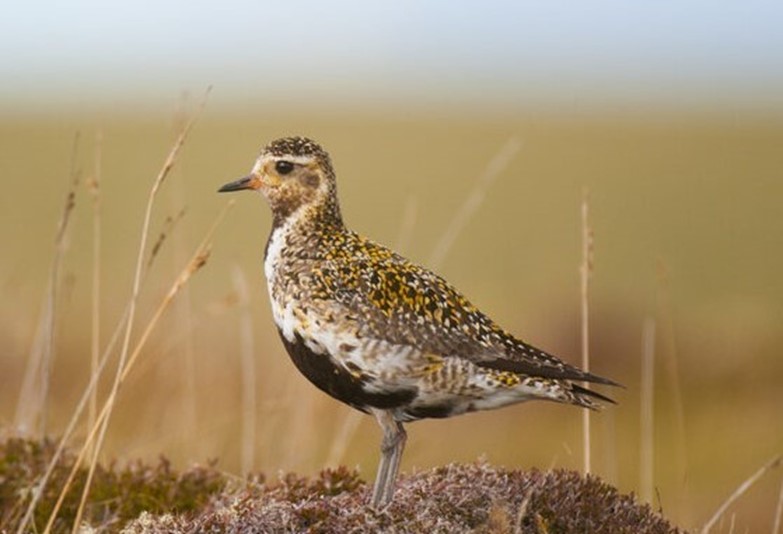
Hen harrier prefer the wet, upland bog areas and the higher hills have breeding pairs of merlin as well as hen harrier. Ring ouzel can also be seen in the spring and autumn passing through to their breeding and feeding grounds. Flocks of fieldfares and redwings can be seen in autumn.
The fast-flowing streams of the Cambrian Mountains are home to dipper and grey wagtail whilst rocky outcrops and scattered trees on the hillside serve as good ‘song posts’ for the tree pippit, whinchat and stonechat.
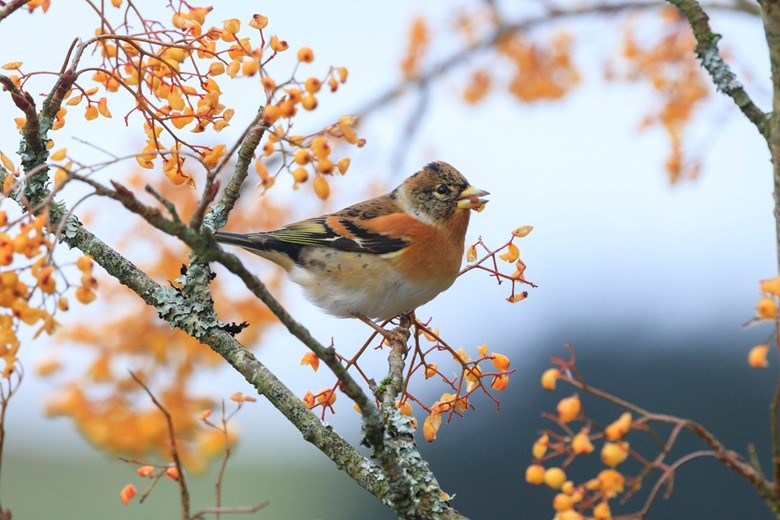
In winter bramblings like beech woodland and farmland fields near woods. Look in flocks of chaffinches and other finches. Redstart, blackcap and warblers are summer visitors to the woodlands, arriving in spring to breed. Siskin and crossbill are found mostly in the coniferous woodland and the goshawk, sparrowhawk and buzzard are resident.
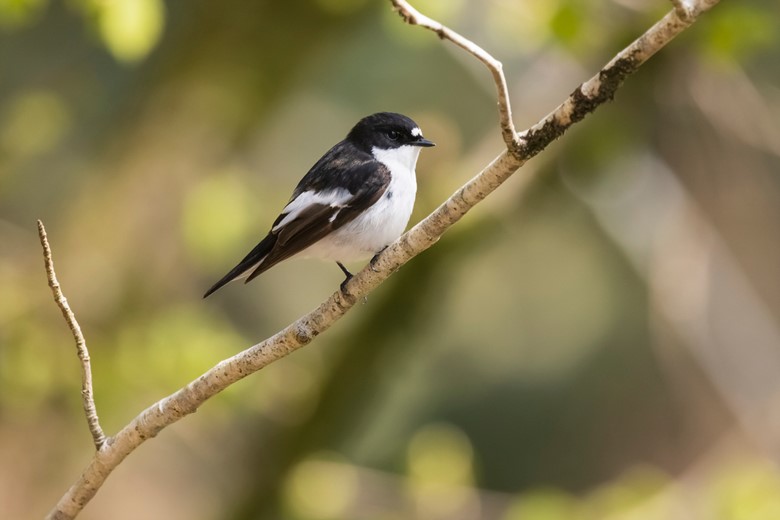
Lower down, in the wooded hillsides, we find pied flycatchers, whinchat and wheatear that arrive in spring to breed and usually stay until late August before returning to Africa to spend the winter months.
Cors Caron
About 70 bird species breed on or near Cors Caron including teal, curlew, snipe and redshank. The beginning of autumn heralds the arrival of passage migrants and various species of wildfowl that overwinter on the lakes and the river. The visitors are likely to include Greenshanks and Green Sandpipers, Wood Sandpipers, Wigeon and Tufted Duck.
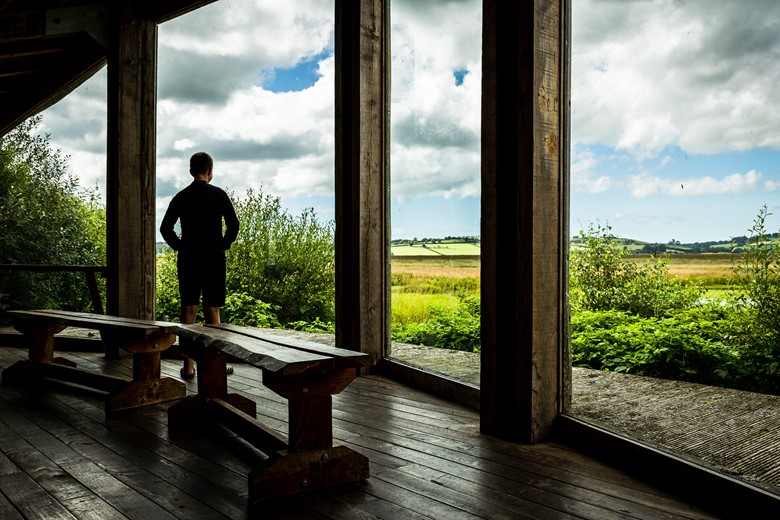
The two thousand acre reserve of raised bog, grassland and woodland astride the upper reaches of the River Teifi is also a winter refuge for the most southerly flock of whooper swans in Britain.
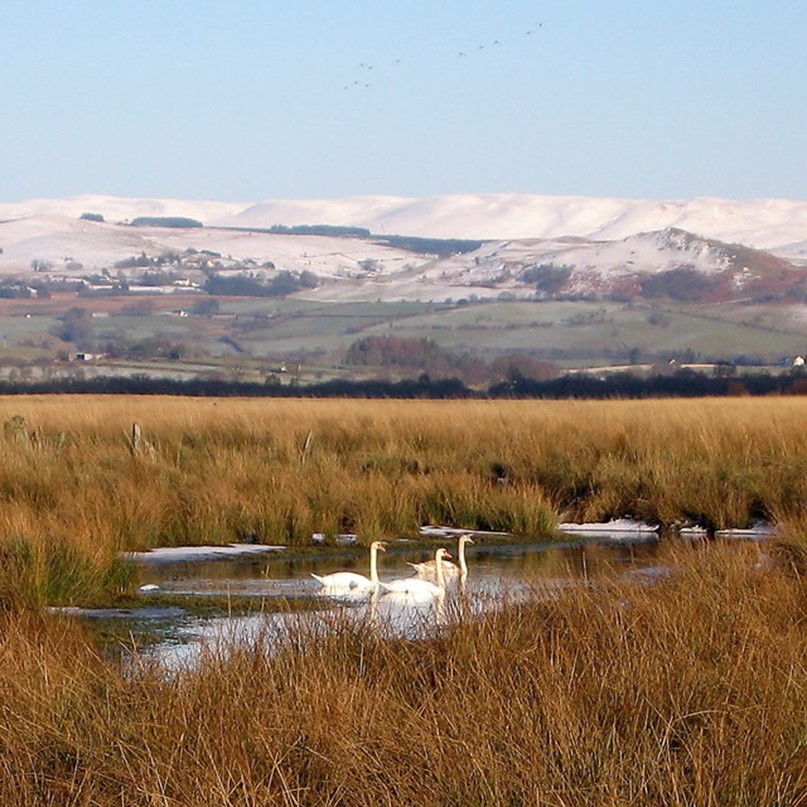
Cors Caron is also an important winter feeding site for Red Kites and Hen Harriers. Other raptors seen there during the year include buzzards, merlins, sparrowhawks, hobbies and goshawks. A high-speed hunter that effortlessly weaves through its woodland home, the goshawk is more easily spotted during late winter and spring, when they break cover for their ‘sky-dance’ display, during which females and males swoop and plunge in a dramatic dance of courtship.
The merlin and hobby, from the falcon family, are the smallest bird of prey in the UK. Extremely fast and agile, hobbies prefer open habitats and consume a large proportion of invertebrates, particularly dragonflies. The merlin is predominantly ground nesting, preferring upland and moorland areas for breeding. Catching its prey on the wing the merlin feeds mainly on small birds.
Summer birdlife ranges from resident wildfowl to an orchestra of redstarts, sedge warblers, meadow pipits and skylarks.
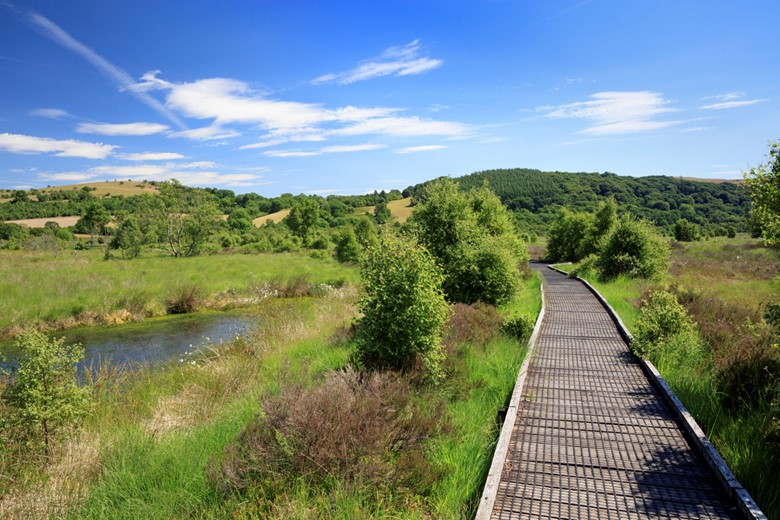
The reserve is easy to visit, with a boardwalk across the bog which takes you to a large hide with extensive views across the bog and river landscape.
Canolfan Bywyd Gwyllt Cors Teifi
the Teifi Marshes form a large part of the Welsh Wildlife Centre reserve, but there is a range of habitats from open pasture and wooded hedgerows as well as the freshwater marsh with open pools and tidal mudbanks.
During winter, part of the reserve area floods, which creates the perfect home for large numbers of wildfowl, notably teal, wigeon and mallard. It’s also the ideal ‘stopover’ for migrating birds like geese. The mudflats of the Teifi and areas of open water also attract little egrets and occasionally bittern. Water Rail are present in winter in considerable numbers, and other regular winter visitors include snipe, curlew and lapwing.
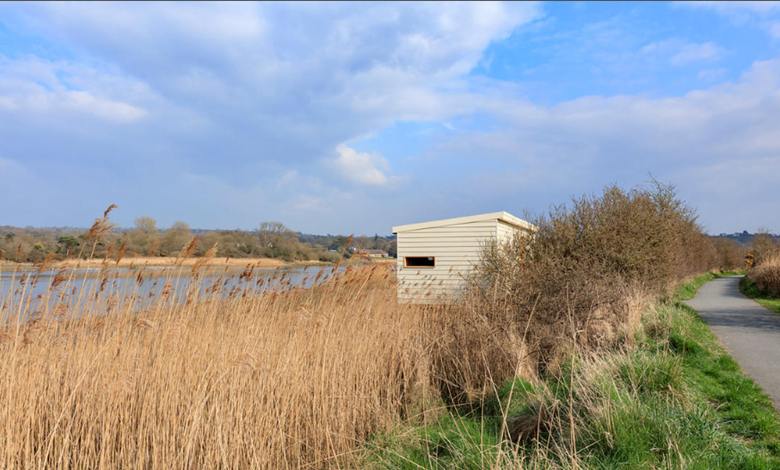
There are hides among the reedbeds which you can get to along a series of boardwalks. There's also a glass fronted cafe and shop with great views over the reserve.
You will be treated to the sight and sound of reed and sedge warblers, Cetti’s warblers and whitethroats. With the falling tide you can spot sanderlings, ringed plover and dunlin. Marsh harriers and peregrine falcons hunt over the marshes and heron breed nearby, whilst the deep pools are frequented by kingfishers, shelduck and moorhen.
Click on the image below to watch the 360 video ' flight of the kingfisher', filmed at the reserve.

